ABSTRACT
In recent years, supply chain instability has intensified due to increasing demand fluctuations, supply disruptions, and transportation interruptions, resulting in continuous volatility in production and operations. To effectively manage external disruptions, manufacturing firms are compelled to adopt flexible operational strategies. The concept of smart and flexible manufacturing has become more critical than ever, offering a key solution for enterprises to enhance their responsiveness to market volatility. Leveraging industry 4.0 technologies, smart-Flexible Manufacturing Systems (Smart-FMS) have emerged as a key solution to mitigate these challenges and ensure business continuity. Smart-FMS enables manufacturers to adapt to fluctuating demand, produce customized products, and address supply chain disruptions. This study offers a comprehensive review of Smart-FMS in the context of disruptions, using keyword cooccurrence analysis, thematic mapping, and thematic evolution analysis. By conducting a structured literature review and bibliometric network analysis of 1,764 research articles from the Scopus database (1965-2023), the study identifies emerging trends, prominent research areas, and future avenues of Smart-FMS. The findings provide valuable insights for manufacturers, engineers, and researchers seeking to implement or refine Smart-FMS in uncertainty environments, ultimately contributing to a more responsive and adaptable manufacturing industry.
INTRODUCTION
The past few decades have witnessed a confluence of trends that pose significant challenges for companies and their leaders. The rise of globalization and production outsourcing has introduced inherent complexities and uncertainties into the manufacturing system. Especially, due to the impact of COVID 19 and the political wars, manufacturing is facing many difficulties in adapting to supply chain disruptions, fluctuating demand, unstable supply, and increasing production costs. For instance, a recent outbreak of coronavirus resulted in widespread disruptions, with long-lasting consequences predicted[1,2] and the political conflict caused numerous consequences to the global economy including inflation, rising fuel prices, and supply chain disruption.[3,4] Additionally, increasingly demanding customers seek more customized products, driving the need for greater product variety and shorter life cycles.[5] Meanwhile, traditional manufacturing processes, often rigid and inflexible, struggle to adapt to these rapid changes and interruptions. In response to this challenge, Flexible Manufacturing Systems (FMS) have emerged as a powerful solution.[6] The initial idea behind an FMS involved computer control of the numerical control machines, the production of diverse parts, and tool magazines capable of holding multiple tools for different machining tasks.[7–9] FMS can be described as a highly automated group technology machine cell, consisting of computer numerical control stations linked by an automated material handling and storage system and controlled by a distributed computer system.[10]
The concept of FMS has been extensively studied in the literature due to its significant potential in optimizing production processes. Several review papers have explored the general concept and characteristics of FMS, providing insights into their structure, functionality, and key components. For instance, Peter (1989) reviewed literature and identified key trend in their research, which is the shift towards a more gradual implementation of flexible systems, starting with Flexible Manufacturing Cells (FMC) and expanding towards full FMS as technology becomes more accessible and cost-effective.[6] They also indicate the importance of future research to improve FMS adaptability, especially in unpredictable manufacturing environments. Sanchez et al., (2001) and Ramesh et al., (2007) also emphasize the importance of integrating both management and technology to achieve agility in manufacturing systems.[11,12] Similarly, Jain et al., (2013) highlighted FMS’s importance as a critical component of gaining competitive advantage in today’s rapidly changing and uncertain manufacturing environments.[13] Perez et al., (2019) further advanced the understanding of flexibility in manufacturing by noting the shift in research focus from an internal, firm-specific view of flexibility to a more contemporary, supply chain-driven perspective.[14] In their study, Perez et al., developed an integrative conceptual model that links manufacturing and supply chain flexibility. Collectively, these existing reviews offer a broad understanding of FMS and the need for further research to enhance its adaptability and integration within FMS under the context of disruption. Additionally, other reviews have focused more specifically on the practical implementation aspects of FMS. For instance, Priore et al., (2001) highlighted the limitations of static dispatching rules in handling the unpredictable nature of FMS, such as machine breakdowns and part arrivals. They proposed that machine learning offers a promising solution to address these challenges.[15] Chawla et al., (2019) conducted a comprehensive analysis of the integration of Automatic Guided Vehicle (AGV) within FMS,[16] emphasizing their critical role in enhancing the efficiency of material handling, ensuring smooth transitions between work centers. These studies, in general, emphasize the importance of advanced technologies such as dynamic scheduling, AGV systems in adapting to changing market demands and improving operational performance. However, despite these extensive reviews, significant research gaps remain in the context of disruptions and industry 4.0 integration. First, while researchers provided a comprehensive review of FMS, most focus on FMS in general,[6,11,12,14] with only disruption at micro levels, such as machine breakdowns or demand variations.[13] This perspective does not fully address the disruptions at macro levels that manufacturers face today, such as global supply chain interruptions, geopolitical instability, or rapid technological shifts. Second, the integration of industry 4.0 technologies into FMS is another critical gap. As manufacturing moves toward increased automation, artificial intelligence, and digital connectivity, the integration of these technologies into FMS has yet to be fully examined. While some studies mention the use of dynamic scheduling and AGV systems,[15,16] few explore the broader implications of smart manufacturing, IoT, and real-time data analytics in enhancing FMS adaptability.
Therefore, this research will focus on using bibliometric methods to the trend of integrating Industry 4.0 technologies into Flexible Manufacturing Systems (Smart-FMS) to address global supply chain disruptions. An extensive bibliometric analysis was conducted using a sample of 1,764 publications retrieved from Scopus between 1965 and 2023. VOSviewer is a bibliometric software tool and was employed to facilitate the analysis. This study seeks to fill a gap in current knowledge and provide valuable insights by addressing a series of key research questions. These questions aim to clarify current trends and offer guidance for future investigations. This paper aspires to conduct a definitive bibliometric analysis of the research field based on the following research questions:
- RQ1: Using performance analysis, what are the influential aspects of a Smart-FMS in disruption context?
- RQ2: Using network analysis, what are the primary research trends of Smart-FMS in disruption context?
- RQ3: What is the directions for future research on Smart-FMS in disruption context?
The remaining of paper is structured as follow: Section 2 thoroughly describes the selected database, search strategy, and the bibliometric methods used. Section 3 presents the analysis results, including performance metrics, scientific mapping visualizations, and key research domains. Based on these findings, section 4 provides strategic recommendations for future research in Smart-FMS. Finally, section 5 summarizes the study’s key findings and acknowledges its limitations.
METHODOLOGY
This review paper will employ a bibliometric analysis methodology that hinges upon the utilization of a comprehensive academic database following the process in Figure 1. This database serves as the cornerstone of the analysis, providing the necessary information and data points to be quantitatively examined. By leveraging the vast repository of bibliographic details within the database, the research will be able to delve into various aspects of the field, including publication trends, authorial influence, and the overall impact of scholarly works.

Figure 1:
Methodology and Data retrieval Process.
This study leverages Scopus, a renowned database offering extensive coverage (22,000+ journals) and well-structured scientific data. Its rigorous review process ensures data accuracy and reliability, making it a valuable tool for gathering information and conducting analyses.[17]
The search string includes keywords related to manufacturing, flexibility, Industry 4.0 technologies, and disruptions to extract relevant literature on Smart-FMS under the global supply chain disruptions. Logical operators like AND or OR refine the search, ensuring results that address both technological integration and system adaptability in disruptive contexts. Collectively, the following search string was employed: (“Manufac*” OR “Producti*”) AND (“flexib*” OR “agile”) AND (“I4.0” OR “smart” OR “Industry 4.0” OR “digit*”) AND (“resilien*” OR “robust*” OR “redunda*” OR “recove*” OR “respons*” OR “adapt*” OR “disrupt*” OR disaster*). This query, covering the period from 1965 to 2023, resulted in a substantial yield of 4840 articles. By incorporating these keywords, we aimed to cast a wide net that would encompass literature discussing the intersection of these crucial themes within the realm of industrial dynamics and technological advancements over the past 5 decades.
Following this, further criteria were chosen in the subsequent stage. These encompassed a wide array of subject areas, including but not limited to Engineering, Computer Science, Business, Management and Accounting, Mathematics, Social Sciences, Economics, Econometrics and Finance, as well as Decision Sciences. Additionally, the document type was refined to solely include articles, and the language was specified to be English. Upon applying these stringent filters, the resulting tally revealed a sum of 1764 articles that met the prescribed criteria.
After retrieving data, VOSviewer and R Studio (Biblioshiny) are applied to analyze the data with constructing network visualizations based on bibliometric data, employing sophisticated algorithms for analysis. R’s object-oriented nature facilitates automation and the creation of new functions, making it highly adaptable for various analytical tasks[18] so we use VOSviewer and R Studio (Biblioshiny) for the analysis part.
The subsequent forms of bibliometric analysis techniques are utilized: 1. Author analysis, 2. The cooperation of Countries and Sources, 3. Keyword co-occurrence analysis, 4. Extraction of Trending Topic.
RESULTS AND DISCUSSION
Annual growth of the number of journal papers
Figure 2 shows the trend of the number of Smart-FMS journal papers. Regarding the trend in recent years, the topic Smart-FMS received great attention from researchers since 2006 with 138 papers. Moreover, the number of this field’s publications rapidly increased by 1,626 papers and reached 1,764 in 2023. FMS combined with digital solutions is the only way to swiftly adapt to changing demands and market conditions. In the period from 2019 to 2022, the gap between the cumulative number of journal papers’ actual and theoretical values has progressively widened each year. We divided the evolution of Smart-FMS research into three different stages. In the inaugural stage, denoted by 1965, the first paper in this field marks its publication. There was no significant growth in the number of papers ranging from 1 to 55 per year before 2016. This phase is identified as the introductory period within the Smart-FMS domain. Regarding the subsequent phase, spanning from 2017 to 2020, the growth rate maintains a steady ascent, averaging around 18%, with a progressive increase observed from 81 to 192. This period is identified as the developmental stage. Finally, from 2021 to 2023 or in the post-2020 period, a surge is seen in the number of journal papers, peaking at the average growth rate of 33.2%, indicating a remarkable upward trend in the quantity of Smart-FMS journal papers, with 220 papers published per year. We denoted this stage as the phase of prosperity within Smart-FMS research. Sarfraz et al., (2021)[19] also indicated that the COVID-19 pandemic might accelerate the advancement of Industry 4.0, potentially paving the way for the fifth industrial revolution including Smart-FMS.

Figure 2:
Annual number of article growth.
Top most author with affiliation and country
Examining the impact of authors in bibliometrics is essential, as it offers valuable insights into the influence and significance of academic researchers.[17] For our analysis, a total of 1,764 journal articles authored by 5,949 individuals have been gathered. To identify core candidates, Price’s Law[20] was initially applied, calculating the minimum number of publications Mp and citations Np for each author. In this field, the values of Mp and Np were 3 and 27.37, respectively. This suggests that authors who fulfilled both criteria of having a minimum of 3 journal articles and 28 cited journal articles were chosen as candidates, resulting in a total of 66 core author candidates. The average number of journal articles and citations of the 66 core author candidates are considered, which are 3.43 and 129.3, respectively. Then, the comprehensive index method (Eq. 1) was employed to evaluate and rank the influence of each core author in the research field, with the weight of the number of publications and citations set to 0.5:[21]
Where Si denotes the comprehensive index for each core author candidate. This index combines two factors (Xi, Yi) which are the number of journal articles and the number of citations for each author. are the average number of articles and citations, respectively.
Applying this formula, the top 10 core authors were identified based on their comprehensive index Si values exceeding 1.322 (Table 1). These authors collectively contributed to a total of 227 journal articles, comprising 12.87% of 1764 journal articles identified in our literature search. This falls considerably short of the 50% threshold predicted by Price’s law, indicating that the research community has not yet established a cohesive core group of authors.[21] As shown in Table 1, top 10 core authors list included authors from diverse countries such as China, Sweden, Munich, Hong Kong, Argentina, and Japan, indicating the global impact of research in the Smart-FMS field. Among those authors, Wang, Lihui from Sweden stands out as the most influential author with an Si of 0.907, 9 papers, and a total of 280 citations. Following closely, Vogel-Heuser, Birgit from Munich secured the second position with a Si of 0.895, derived from 6 papers and 356 citations. Other influential authors within this field include Berggren, Magnus (3 papers, 391 citations), Huang, George Q. (9 papers, 152 citations), and Li, Di (4 papers, 270 citations).
| Rank | Author | Affiliation | Country | No. of Paper | Total citations | Si |
|---|---|---|---|---|---|---|
| 1 | Wang, Lihui | KTH Royal Institute of Technology | Sweden | 9 | 280 | 2.391 |
| 2 | Vogel-Heuser, Birgit | Technical University of Munich | Munich | 6 | 356 | 2.249 |
| 3 | Berggren, Magnus | Linköping University | Sweden | 3 | 391 | 1.95 |
| 4 | Huang, George Q. | University of Hong Kong | Hong Kong | 9 | 152 | 1.90 |
| 5 | Li, Di | South China University of Technology | China | 4 | 270 | 1.63 |
| 6 | Zhang, Yingfeng | Northwestern Polytechnical University | China | 7 | 152 | 1.605 |
| 7 | Rossit, Daniel Alejandro | Universidad Nacional del Sur | Argentina | 3 | 256 | 1.43 |
| 8 | Leng, Jinsong | Harbin Institute of Technology | China | 4 | 218 | 1.42 |
| 9 | Liu, Yanju | Harbin Institute of Technology | China | 4 | 218 | 1.42 |
| 10 | Huang, Tsung-Ching | University of Tokyo | Japan | 3 | 229 | 1.32 |
The annual productivity of those authors along with their corresponding citation counts is illustrated in Figure 3. In the visualization, a larger circle indicates a higher number of articles, while a denser circle represents a greater number of citations. The majority of authors over time entered the Smart-FMS field starting in 2017, aligning with the rising trend of Industry 4.0. Wang, Lihui, a leading author in this field, began his contributions in 2017 and reached peak productivity in 2023, making him the most productive author of this year. Despite not being listed among the top 10 core authors, three other authors (i.e. Combs, Greg; Benson, Brad; Liu, Qin) remain highly ranked in terms of productivity over time, thanks to their highly cited paper from 2011. A similar situation occurred with Li, Mingxing and Wang, Xi Vincent. They are emerging authors and become productivity in 2023.

Figure 3:
Authors’ production in the Smart-FMS area. Source: Biblioshiny/Scopus.
Co-authorship with the authors’ unit of analysis refers to the collaboration of two or more authors on a document, providing insights into patterns of collaboration within the academic community.[22] Figure 4 presents the collaboration diagram generated by VOSviewer, illustrating the network of author collaborations within retrieved journal articles. Each node represents an author, and node size corresponds to the number of journal papers attributed to that author. The connections between nodes indicate the frequency of collaboration, with thicker lines signifying closer and more frequent collaboration between those authors. Figure 4 shows the identical research group among core authors in Smart-FMS field. Wang, Lihui emerges as central figure, closely collaborating with Zhang, Yingfeng and Wang, Xi Vicent. It results in a permanent partnership in the co-authorship network. Similarly, Huang, Tsung-Ching shows significant connections with Wu, Wei; Li, Mingxing and Guo, Daqiang despite these authors are not being listed in top 10 core authors. In contrast, there are several authors positioned in isolated cluster, such as Li, Di; Vogel-Heuser, Birgit; Leng, Jinsong; etc, indicating less frequent collaboration with core authors and likely focusing on distinct subdomains. Based on Table 1 with the implications of Price’s law and the co-authorship network in Figure 4, it can be suggested that a stable core author group has yet to emerge in this field. This indicates ample opportunity for further in-depth study of Smart-FMS by other scholars.
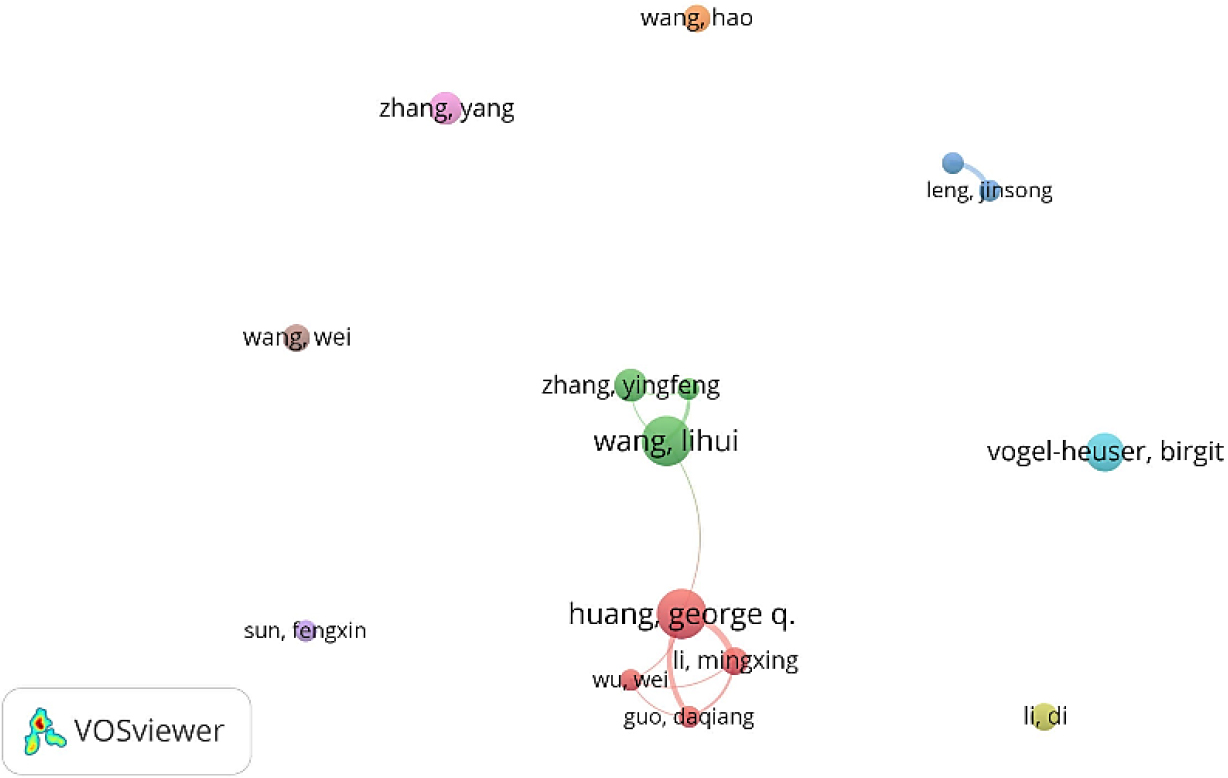
Figure 4:
Author cooperation diagram produced by VOSviewer.
The most contributive nation in the domain of Smart-FMS research is shown in Table 2. Specifically, a total of 2143 publications related to Smart-FMS topics were distributed across 36 countries (or territories). This observation underscores a notable scholarly interest in the sphere of Smart-FMS. However, a remarkable examination of the geographic distribution of authors reveals an imbalance within this knowledge domain (see Table 2). China emerges as the leading contributor to research on the Smart-FMS field, with 281 publications attributed to authors from this nation. China exhibits a substantial representation in both publications originating from a single country (204 SCPs) and those involving multiple countries (77 MCPs), underscoring its extensive involvement in global research partnerships.
| Country | Articles | SCP | MCP | Freq | MCP_Ratio |
|---|---|---|---|---|---|
| China | 281 | 204 | 77 | 0.153 | 0.274 |
| USA | 165 | 129 | 36 | 0.09 | 0.218 |
| India | 100 | 77 | 23 | 0.055 | 0.23 |
| United Kingdom | 86 | 44 | 42 | 0.047 | 0.488 |
| Germany | 72 | 51 | 21 | 0.039 | 0.292 |
| Italy | 53 | 30 | 23 | 0.029 | 0.434 |
| Spain | 39 | 26 | 13 | 0.021 | 0.333 |
| Australia | 32 | 20 | 12 | 0.017 | 0.375 |
| Korea | 29 | 18 | 11 | 0.016 | 0.379 |
Regarding Figure 5, the color of nodes signifies the respective countries’ levels of experience in the field of Smart-FMS. Nodes shaded in purple (e.g., United States, China, Singapore, Hong Kong) denote countries whose authors possess substantial prior experience in Smart-FMS research (pre-2012). Conversely, nodes shaded in green (e.g., United Kingdom, Australia, Pakistan, Saudi Arabia) indicate countries where co-authors appear to have commenced their engagement with Smart-FMS literature between 1965 and 2023. Notably, Spain and Colombia emerge as newcomers to this research domain. Of interest, despite the United States’s status as the second most prolific contributor to Smart-FMS literature, authors from this nation do not exhibit commensurate levels of prior experience in the field. The width of lines connecting nodes illustrates patterns of co-authorship between scholars from respective countries. Wider lines correspond to a higher volume of publications co-authored by representatives from the two nations. As described in Figure 5, the most prevalent co-authorship relationships in the realm of Smart-FMS research involve China-United States and China-United Kingdom, followed by United States-United Kingdom collaborations.
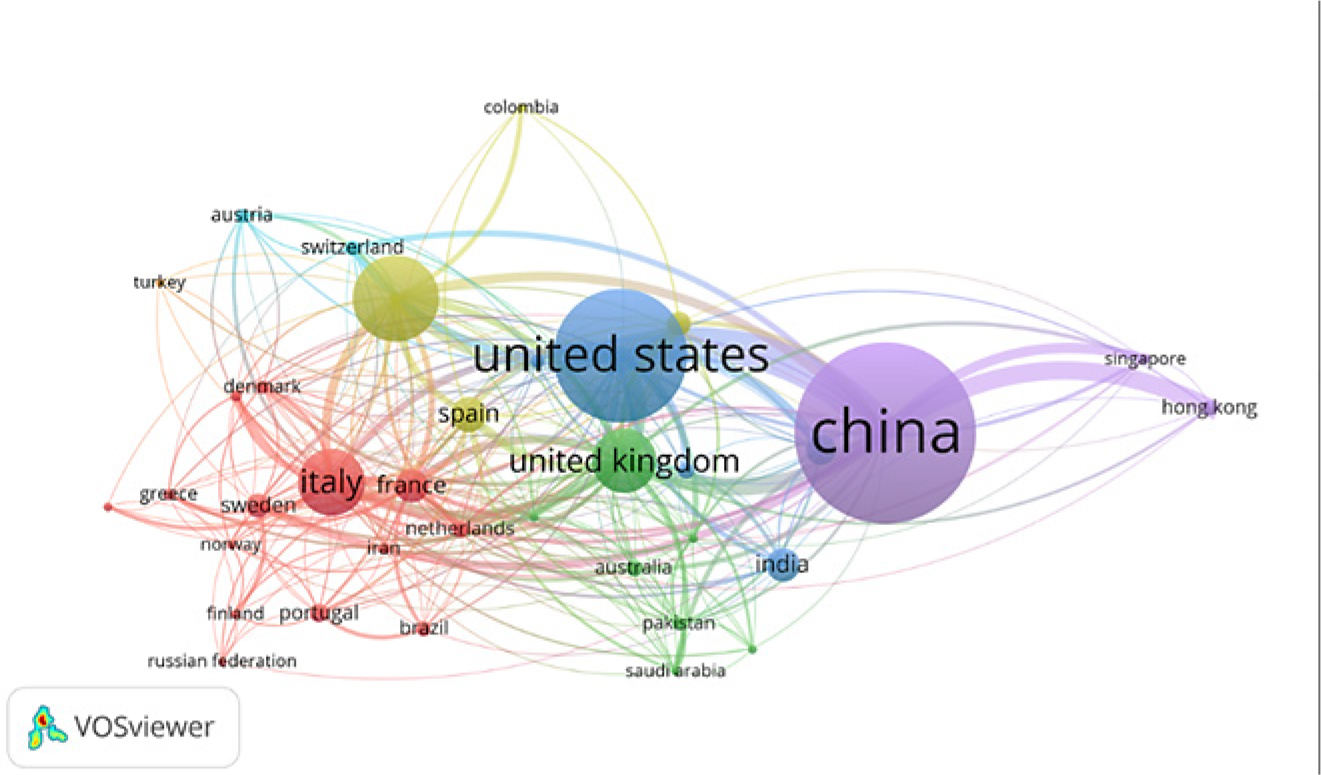
Figure 5:
The respective countries’ level of experience in Smart-FMS.
We analyzed the contributions of various research institutions to Smart-FMS research, utilizing data extracted from RStudio software and visualized through VOSViewers, as depicted in Figure 6. According to the findings, ten institutions are highlighted based on their publication output. Leading the pack is Dalian University of Technology with 29 papers, followed closely by Shanghai Jao Tong University and Imperial College London, contributing 25 and 24 journal papers, respectively. Notably, five out of the top ten prolific organizations hail from China, indicating the maturity and widespread acknowledgment of Smart-FMS research within the country. Among the top-ranking institutions, Delft University of Technology, North China Electric Power University, and RWTH Aachen University exhibited the lowest number of published articles, each with 18 contributions.
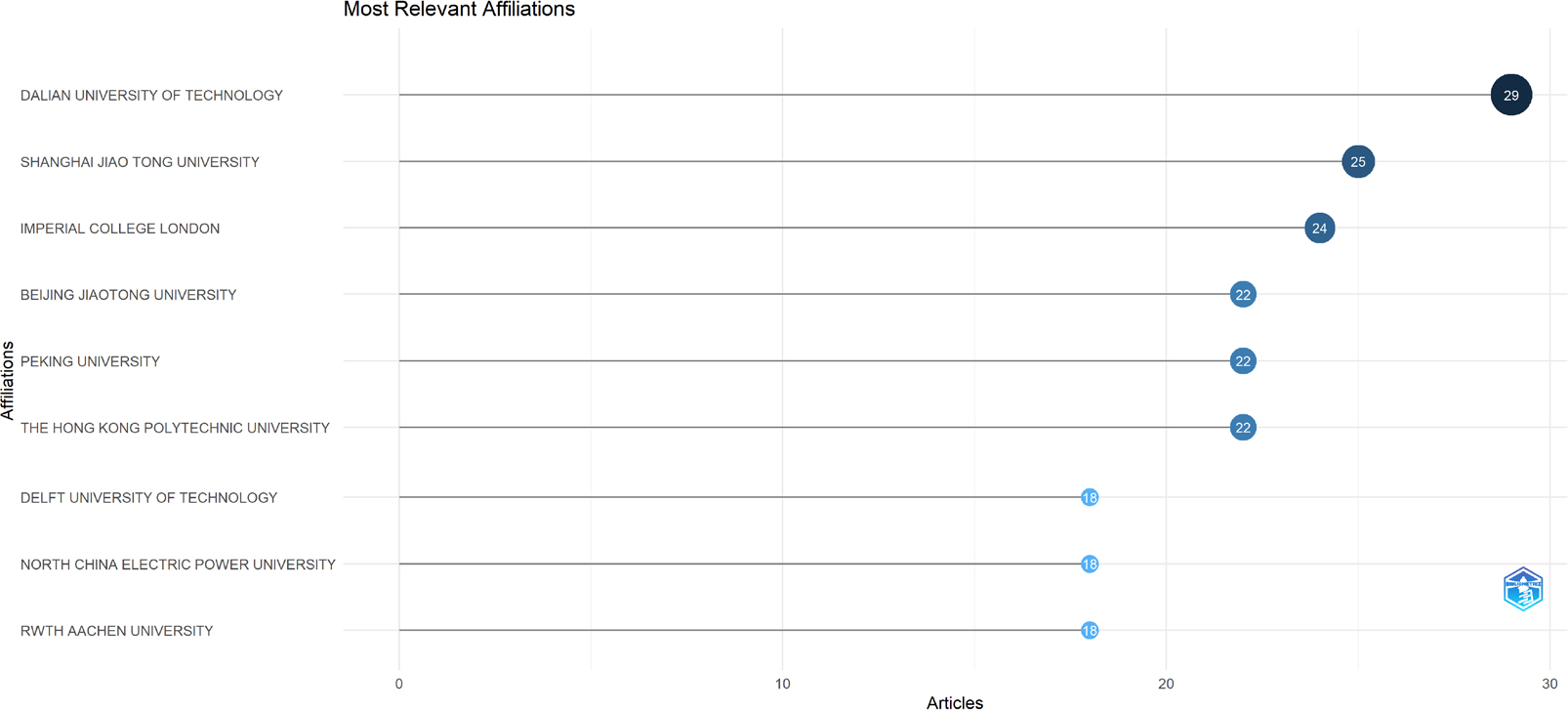
Figure 6:
The contribution of research institutions in Smart-FMS.
Analysis of literature sources and documents
In this section, we analyze how articles are distributed across top-tier economics journals to see valuable insights into their research focus and productivity. Journals with more articles indicate a higher volume of research output and likely cover a wider range of topics. They act as platforms for researchers to share their findings and participate in academic discussions. Among the core journals analyzed, the top 10 most productive ones have been identified, as depicted in Figure 7. Leading the pack is the Sustainability Journal based in Switzerland, boasting 41 published papers, a testament to its prominent status within the academic landscape. Its concentration on the intersection of sustainable development and Smart-FMS research garners substantial scholarly interest, enriching the field’s knowledge base. Furthermore, three of these top 10 journals, each featuring over 24 papers, center their focus on the production sector, underscoring the significant attention to agile manufacturing by researchers. Additionally, specialized journals like IEEE Transactions on Power Electronics or IEEE Journal of Solid-state Circuits cater to specific research domains, facilitating comprehensive exploration and analysis.
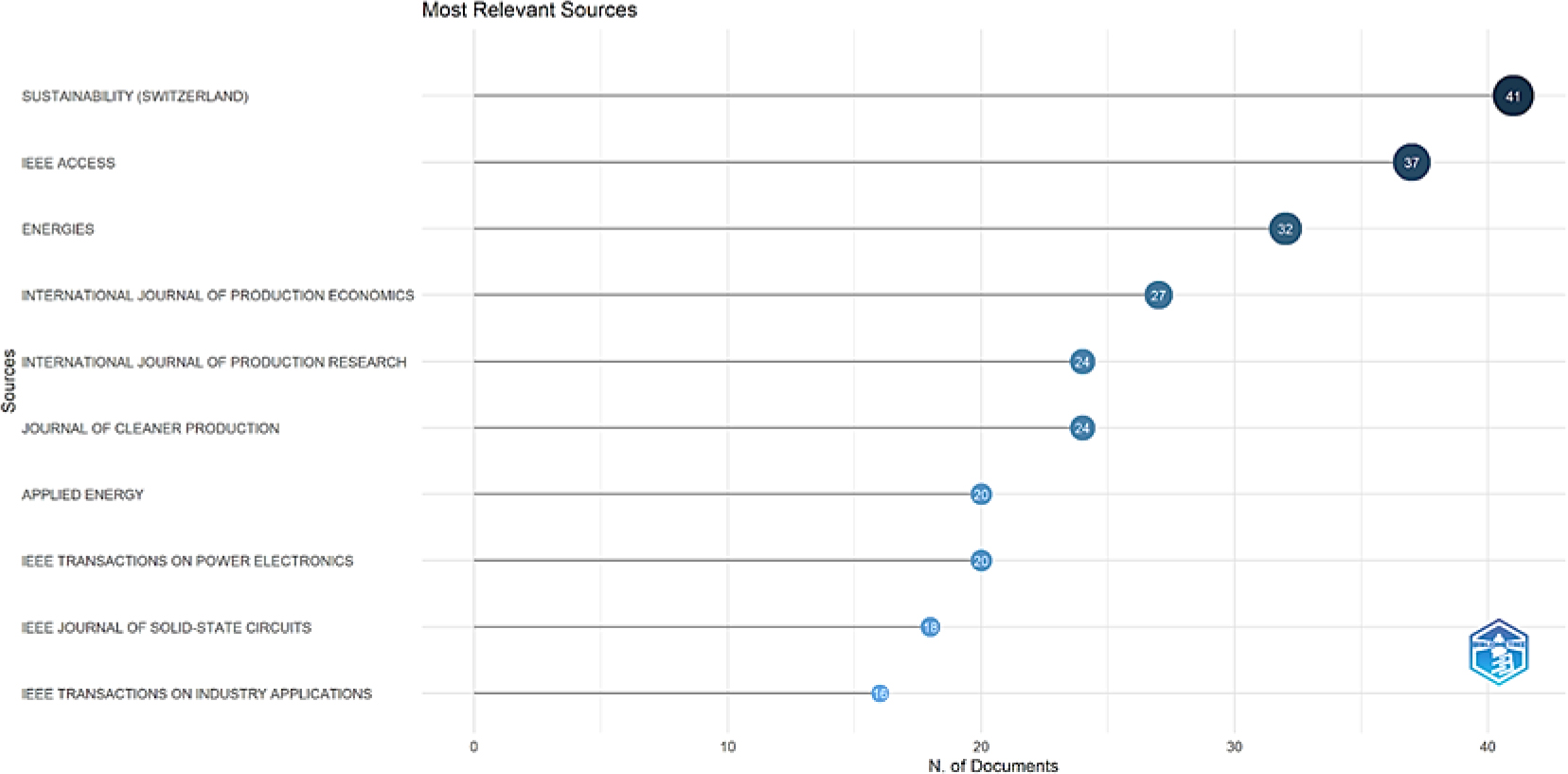
Figure 7:
Top 10 productive jounal sources in Smart-FMS
In addition, our emphasis lies in conducting a citation analysis, wherein we scrutinize the references cited within scholarly publications, encompassing both general sources and specific datasets. This examination allows us to discern the interrelations among these cited works, thereby facilitating a deeper understanding of the evolutionary trajectories within the Smart-FMS research sphere. Table 3 delves into papers exhibiting the highest co-citations within our localized dataset along with information about each author, year of publication, global citation, normalized Global Citation, Local Citation, normalized local citation, and LC/GC ratio (%). Specifically, the paper authored by Borini S in 2013 garnered the highest number of global citations with 749, followed closely by the research conducted by Kvatinsky et al., in 2013, amassing 628 citations. Furthermore, the list includes works by Rojko et al., (2017),[23] Pop et al., (2018),[24] Li et al., (2019),[25] Guo et al., (2018)[26] and Jensen et al., (2017)[27] published in post-2017, which have also received considerable citations and recognition for their research findings. It is important to note that 7 out of 10 papers have received limited Local Citations (LC) despite a notable number of Global Citations (GC).
| Document by: | Year | GC | NGC | LC | NLC | LC/GC Ratio (%) |
|---|---|---|---|---|---|---|
| Borini et al., (2013)[28] | 2013 | 749 | 7.13 | 0 | 0.00 | 0.00 |
| Kvatinsky et al., (2013)[29] | 2013 | 628 | 5.98 | 0 | 0.00 | 0.00 |
| Rojko A (2017)[23] | 2017 | 583 | 12.40 | 6 | 11.30 | 1.03 |
| Baeg et al., (2013)[30] | 2013 | 478 | 4.55 | 0 | 0.00 | 0.00 |
| Pop et al., (2018)[24] | 2018 | 477 | 11.44 | 0 | 0.00 | 0.00 |
| Brahman et al., (2015)[31] | 2015 | 417 | 9.58 | 1 | 3.18 | 0.24 |
| Li et al., (2019)[25] | 2019 | 349 | 9.11 | 0 | 0.00 | 0.00 |
| Andersson et al., (2007)[32] | 2007 | 338 | 12.34 | 1 | 18.00 | 0.30 |
| Guo et al., (2018)[26] | 2018 | 325 | 7.79 | 0 | 0.00 | 0.00 |
| Jensen et al., (2017)[27] | 2017 | 301 | 6.40 | 0 | 0.00 | 0.00 |
Analysis of keywords and thematic
Visualization of co-occurring keywords
Keywords act like labels or key terms that capture the main ideas of research articles. By analyzing how often these words appear together, we can understand the overall research focus. Following Zupic and Čater (2006),[33] we used VOSviewer software to conduct a keyword co-occurrence analysis to identify the key themes in Smart-FMS research. From 5,642 identified keywords from author keywords, 62 were selected for analysis with a minimum occurrence threshold of 10.
Figure 8 illustrates the resulting keyword co-occurrence map for journal papers published between 1965 and 2023. Word size reflects keyword frequency. Industry 4.0 (249 papers) emerged as the top keyword, followed by internet of things (IoT) (80), smart manufacturing (79), cyber-physical systems (72), digital twins (62), and flexibility (58). Evidently, digital technologies represent a central theme. This reflects the current technological advancements that are driving and enabling greater responsiveness in manufacturing processes, personalizing products based on individual customer needs, and ultimately achieving mass customization. Scholars are actively seeking ways to leverage these technologies in production systems through their ongoing research.

Figure 8:
Keyword co-occurrence Visualization. Source: Biblioshiny.
Cluster analysis of high-frequency keywords
The results of the VOSviewer co-occurrence analysis are presented in Figure 9 and Table 4. There are five clusters of keywords are identified, each represented by a different color in Figure 9. Each circle represents a specific keyword and indicates a sub-area within the broader theme of Smart-FMS networks. Larger circles indicate keywords that appear more frequently. Circles with similar colors show related keywords within a particular cluster. Cluster 1 (Red): This cluster focuses on advanced manufacturing technologies for Smart-FMS and includes keywords like flexibility, additive manufacturing, 3D printing, robots, smart textiles, flexible electronics, and smart materials.[34–36] Cluster 2 (Green): This cluster centers on Industry 4.0 and sustainability and includes keywords like Industry 4.0, digitalization, sustainability, digital technologies, and the COVID-19 pandemic.[37,38]
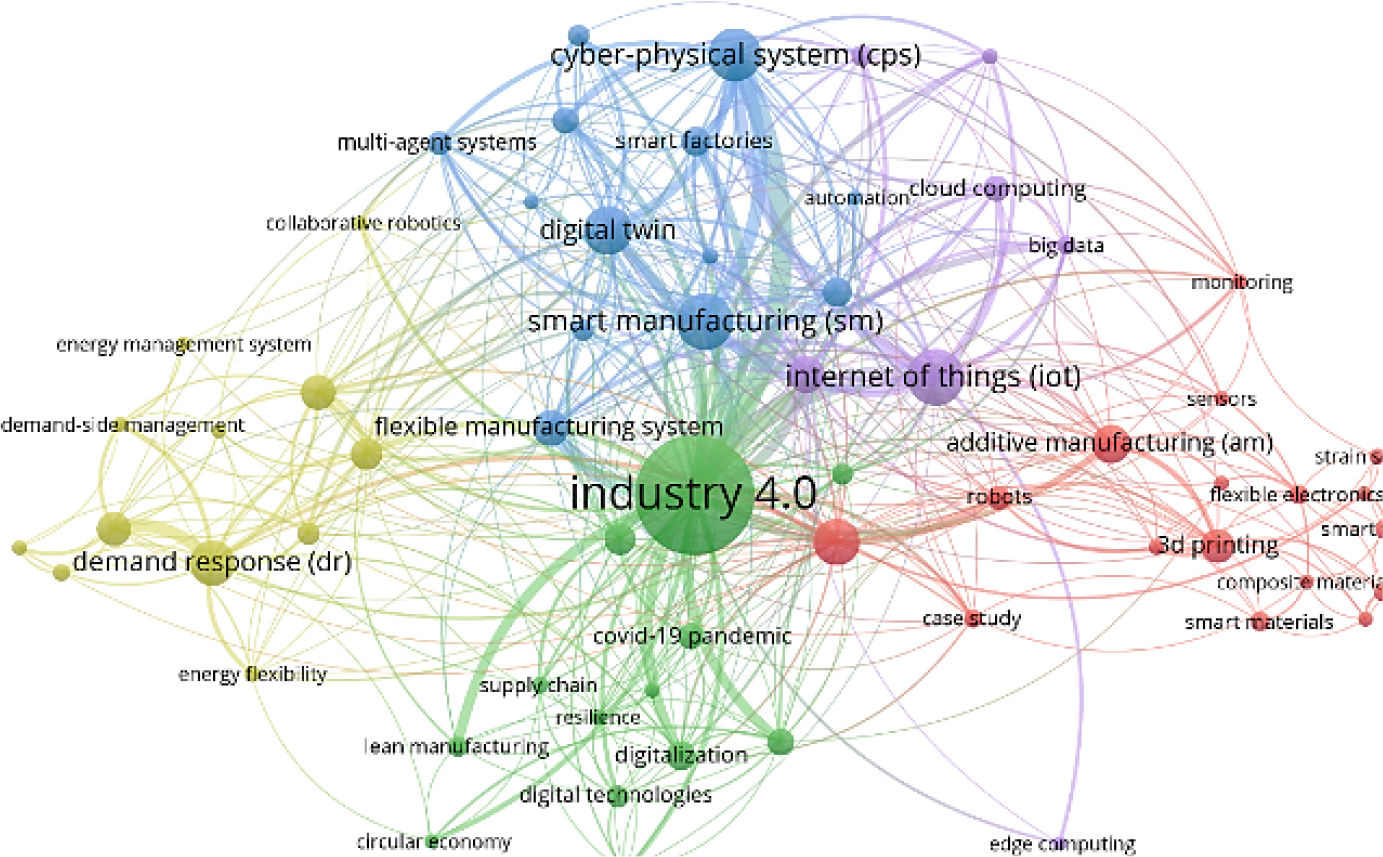
Figure 9:
Cluster analysis of high-frequency keywords. Source: VOSviewer.
| Sl. No. | Color | Cluster | Keywords and Frequency |
|---|---|---|---|
| 1 | Red | Advanced Manufacturing Technologies | flexibility (58), additive manufacturing (45), robots (22), smart textiles (17), flexible electronics (16), smart materials (15),… |
| 2 | Green | Industry 4.0 and sustainability | industry 4.0 (249), digitalization (29), sustainability (26), covid-19 (24), digital technologies (20), lean manufacturing (17),… |
| 3 | Blue | Smart Manufacturing | smart manufacturing (79), cyber-physical system (72), digital twin (62), human-robot collaboration (25), multi-agent (21),… |
| 4 | Yellow | Optimization | demand response (57), optimization (38), smart grids (36), planning and scheduling (32), energy storage systems (13),… |
| 5 | Purple | AI and bigdata | internet of things (80), artificial intelligence (42), cloud computing (25), big data (15), edge computing (10),… |
Cluster 3 (Blue): This cluster highlights Smart Manufacturing. Keywords include smart manufacturing, cyber-physical system, digital twin, flexible manufacturing system, human-robot collaboration, and multi-agent systems.[39–41] Cluster 4 (Yellow): This cluster focuses on Optimization in Smart-FMS. Keywords include demand response, optimization, smart grids, planning and scheduling, energy storage systems, and energy flexibility.[42–44] Cluster 5 (Purple): This cluster emphasizes AI and bigdata, with keywords like Internet of Things, artificial intelligence, cloud computing, deep learning, big data, predictive maintenance, and edge computing.[45–47]
The shift in Smart-FMS studies over time
Building on the keyword co-occurrence analysis, we can delve deeper into the dynamics of current research teams and identify trending topics. To visualize the evolution of research in Smart-FMS, VOSviewer offers a valuable tool called overlay visualization. This technique employs a color gradient, where purple signifies earlier publications and transitions to green and yellow for more recent ones. This visual aid effectively highlights the chronological emergence of keywords and their average publication year, revealing the shifting research interests of scholars across different time periods.[48]
The overlay visualization in Figure 10 reveals distinct research phases in Smart-FMS: In the early period (dark colored nodes), scholarly interest focused on optimizing manufacturing processes and systems, such as: demand response (2019.12), smart grids (2018.75), simulation (2018.16), productivity (2018.64), energy management system (2018.91), monitoring (2015.82), and flexible electronics (2018.94). Next, the issues of concern focused integration of Industry 4.0 technologies, including: industry 4.0 (2020.89), internet of things (2020.43), smart manufacturing (2020.77), cyber-physical system (2020.50), flexibility (2020.41), additive manufacturing (2020.62), and flexible manufacturing system (2020.20). Later, scholars highlighted the integration of digitalization and sustainability efforts, including digitalization (2021.31), sustainability (2021.31), flexible sensors (2021.09), and edge computing (2021.00). Recently, scholars emphasized the resilience and artificial intelligence in manufacturing systems, including: COVID-19 pandemic (2021.79), resilience (2022.17), digital twin (2021.79), machine learning (2021.60), human-robot collaboration (2021.76), deep learning (2021.58), reinforcement learning (2021.80).
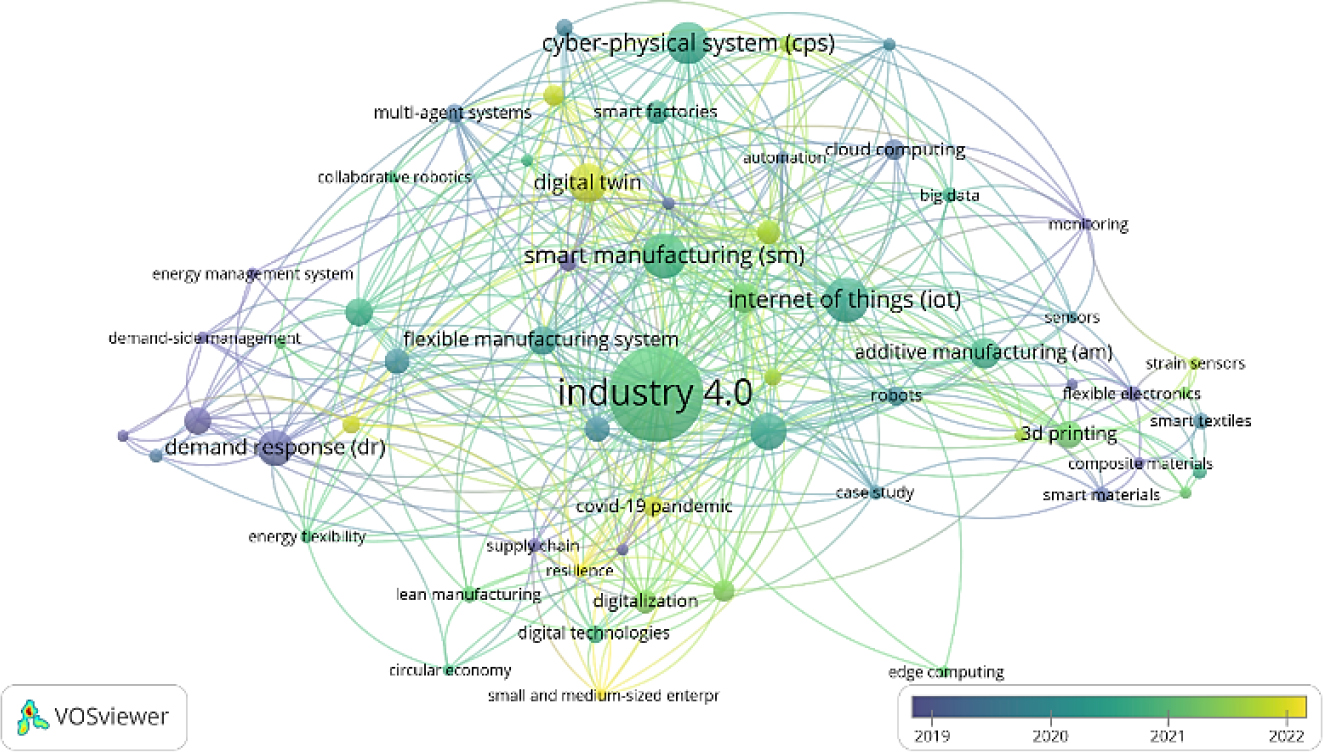
Figure 10:
Overlay Visualization of bibliographic coupling document. Source: VOSviewer
Thematic analysis
In addition to the keyword co-occurrence analysis, we employed the Biblioshiny package in R programming to visualize a thematic map based on author keywords Figure 11. This technique helps identify and display the key themes within a research field.[49]
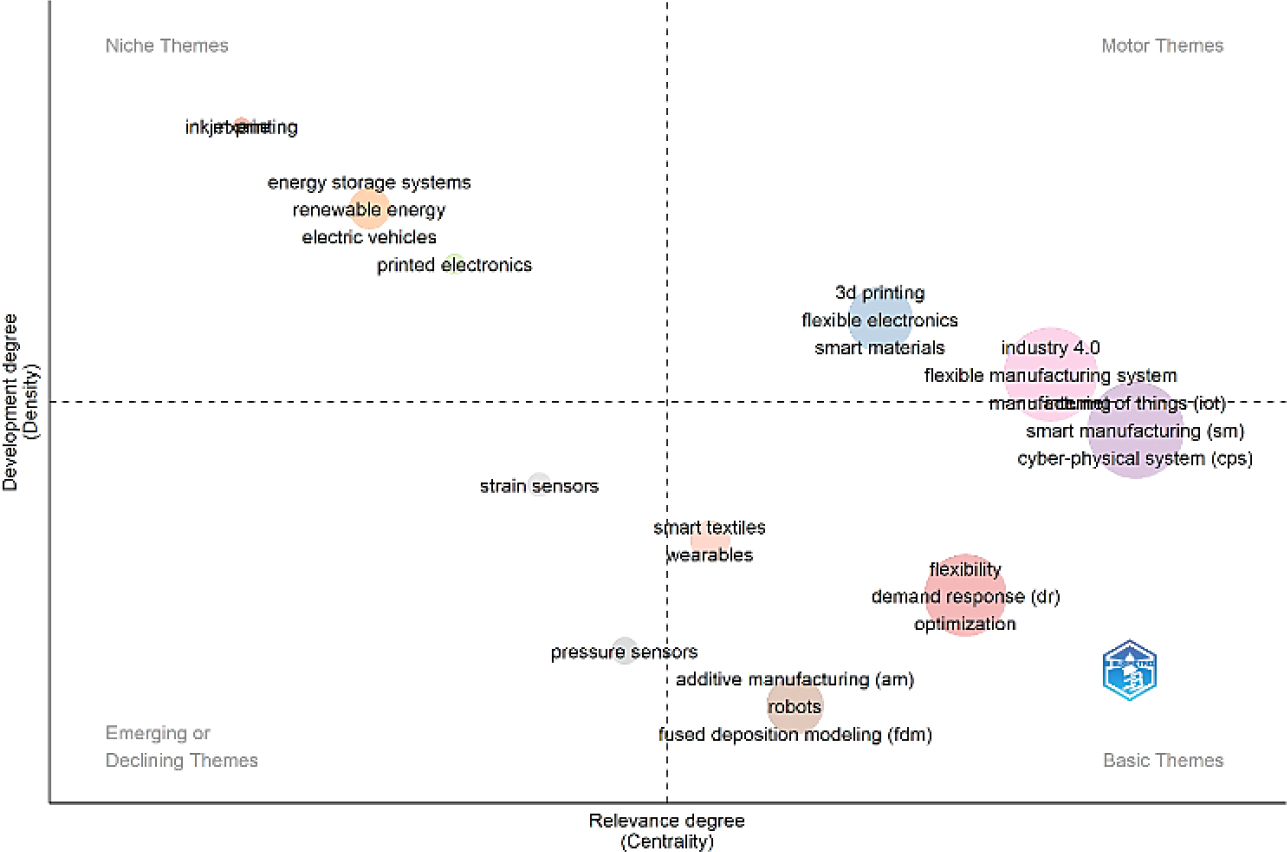
Figure 11:
Thematic map. Source: Biblioshiny.
The thematic map reveals four key areas of research within Smart-FMS: (i) Motor Themes: These highly prominent themes focus on advanced manufacturing innovations, such as 3D printing, flexible electronics, smart materials, Industry 4.0, and Smart-FMS itself. These advancements are shaping the future of manufacturing. (ii) Niche Themes: These specialized themes deal with sustainable energy and mobility solutions, including energy storage systems, renewable energy, electric vehicles, and printed electronics. This area explores how Smart-FMS can contribute to a more sustainable future; (iii) Basic Themes: These core themes encompass smart manufacturing technologies like the internet of things (IoT), cyber-physical systems, additive manufacturing, and optimization techniques. These fundamental concepts underpin advancements in Smart-FMS; (iv) Emerging/Declining Themes: Strain and pressure sensors are only two themes that is solidly within this quadrant. Since Smart-FMS is a field of research that has grown rapidly in recent years, these themes are likely emerging.[50,51]
The biblioshiny package in R offers another valuable tool: thematic evolution analysis. This technique allows researchers to visualize how research topics merge, diverge, or gain prominence over time.[49] Figure 12 presents an alluvial diagram, a type of flow chart, that depicts the thematic evolution of the Smart-FMS research field from 1965 to 2023. The diagram divides the analysis into three distinct periods, mirroring the analysis in section 3.1 on annual growth of publications Figure 12. Phase 1 (1965-2016): The Formative Stage, this initial period represents the embryonic stage of Smart-FMS research, where scholars focused on defining the concept itself and exploring core themes. Phase 2 (2017-2020): Industry 4.0 Integration, the second phase witnessed a shift in research focus towards Industry 4.0 technologies. Prominent themes during this period include 3D printing, industry 4.0 itself, demand response, smart materials, additive manufacturing, and mechanical properties.[52,53] Phase 3 (2021-2023): Continued Development and Emerging Themes, the most recent period (2021-2023) demonstrates continuity in some themes like demand response, 3D printing, and Industry 4.0. However, it also highlights the emergence of more detailed areas of research, such as smart textiles, robotics, and optimization.[38,39,54]
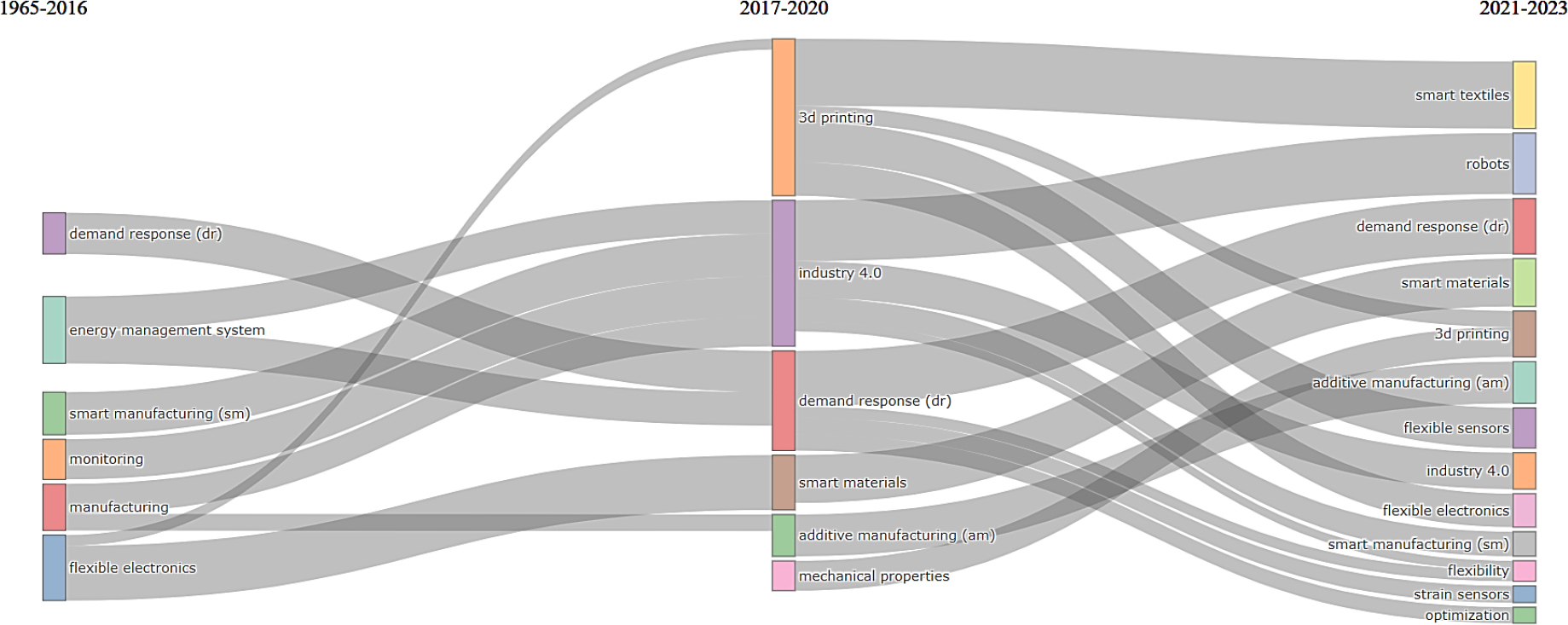
Figure 12:
Thematic evolution. Source: Biblioshiny.
Directions for building Smart-FMS in disruption contexts
Smart-FMS has been a manufacturing trend since 1965, but it wasn’t until 2016 that this manufacturing trend developed significantly and robustly up to now. This is also a milestone closely related to the ongoing Fourth Industrial Revolution. In the context of global production and consumption economies experiencing many fluctuations and disruptions as they are currently, the trend of flexible manufacturing will be even more prevalent in the near future. In terms of management aspects to foster the strong development of Smart-FMS trends, it requires three systems for building up Smart-FMS in disruption contexts.
Automated raw material transportation system
Manufacturing operation and equipment integration system: managing Work in Progress (WIP), machine technical specifications, flexible planning and coordination, implementing SMED (Single-Minute Exchange of Die) for quick changeovers, connecting various machinery systems in production, factory operation.
Equipment technical system: machine diagnosis, equipment maintenance, data collection, measurement integration, fault diagnosis and classification, batch control, real-time decision-making.
CONCLUSION
Smart-FMS research has a rich history, with numerous review studies[55–57] offering valuable insights into strategic guidelines for Smart-FMS development and implementation. However, the emergence of Industry 4.0 and the growing need for resilience have led to a surge in Smart-FMS-related research recently. Since Jain et al.,[57] published their review paper in 2012, Scopus have recorded over 1,500 new articles related to Smart-FMS, digital technologies, and disruptive contexts. To identify emerging trends, prominent research areas, and future avenues, we conducted this comprehensive bibliometric analysis of 1,764 Scopus articles published between 1965 and 2023.
We used keywords co-occurrence analysis and identified five major thematic clusters. While traditional themes like, Advanced Manufacturing Technologies and Optimization remain relevant with previous researches,[56,57] we found that Industry 4.0 and sustainability, Smart Manufacturing, AI and bigdata have emerged as prominent focus areas. Thematic analysis confirmed their significance by arranging them into Prominent themes and Neche theme. Thematic evolution analysis revealed a trend towards greater diversity in Smart-FMS research. Based on our findings, we recommended directions for future research, potentially focusing on the integration of emerging technologies like artificial intelligence and machine learning with Smart-FMS or exploring the application of Smart-FMS in sustainable manufacturing domains. Such research can provide valuable insights for developing Smart-FMS in uncertain environments supported by Industry 4.0 technologies.
Our findings offer valuable insights for related stakeholders in the post-pandemic ear by highlighting the most impactful themes and emerging trends in Smart-FMS research. These insights can inform organizational practices to enhance their flexibility, resilience, and sustainability in the face of evolving challenges. This knowledge can also empower researchers to identify innovative opportunities within the Smart-FMS literature.
Cite this article:
Hoa NTX, Tuyen NT, Anh VH, Anh NP, Anh ND, Quynh TH. Bibliometric Method for Reviewing Smart Flexible Manufacturing Systems in Disruption Contexts. J Scientometric Res. 2025;14(2):447-459.
LIMITATIONS
One of the limitations of this study is the reliance on a single database for sample collection on Scopus. While this approach offers a streamlined analysis, it potentially excludes valuable insights from publications housed in other databases. Expanding the sample to encompass publications from additional databases in future studies would provide a more comprehensive picture of the research landscape and potentially reveal new perspectives or trends.
Furthermore, the study acknowledges that the use of a limited set of search phrases might have inadvertently omitted relevant articles. Certain keywords or terminology variations may not have been captured, leading to the potential exclusion of important research. To address this limitation, future studies could benefit from employing a broader range of search phrases, potentially incorporating synonyms, related terms, and alternative spellings. Additionally, utilizing advanced search techniques, such as Boolean operators or thematic analysis, could further refine the search and ensure a more comprehensive capture of relevant literature.
Despite these limitations, the present study lays a valuable foundation for further investigation in this area. By acknowledging these shortcomings, the study provides a framework for future research endeavors to build upon. By incorporating the suggested improvements regarding database selection and search phrase expansion, future studies can conduct more robust analyses and enhance the generalizability of their findings. This will ultimately contribute to a deeper understanding of the research topic and potentially lead to significant advancements in the field.
References
- Byerik S.. [Apr 3 2024];Coronavirus impact: 94% of the Fortune 1000 are seeing supply chain disruptions; 2020.. Fortune [Internet]. [Google Scholar]
- Govindan K, Mina H, Alavi B.. A decision support system for demand management in healthcare supply chains considering the epidemic outbreaks: A case study of coronavirus disease 2019 (COVID-19).. Transp Res E Logist Transp Rev.. 2020;138:101967. [PubMed] | [CrossRef] | [Google Scholar]
- Chawla VK, Chanda AK, Angra S. Automatic guided vehicle systems in flexible manufacturing system¨CA review.. Int J Ind Eng Theory Appl Pract.. 2019;26(5):36¨C51 [PubMed] | [CrossRef] | [Google Scholar]
- Minh Ngoc N, Thanh Viet D, Hoang Tien N, Minh Hiep P, Tuan Anh N, Dinh Hue Anh L, et al. Russia-Ukraine war and risks to global supply chains.. International Journal of Mechanical Engineering.. 2022;7(6) [PubMed] | [CrossRef] | [Google Scholar]
- Brette M, Friederichsen N, Keller M, Rosenberg M, Virtualization H.. Decentralization and network building change the manufacturing landscape: an Industry 4.0 perspective.. Int J Mech Aerosp Ind Mechatron Manuf Eng.. 2014;8(1):37-44. [PubMed] | [CrossRef] | [Google Scholar]
- O’Grady P. Flexible manufacturing systems: present development and trends.. Comput Ind.. 1989;12(3):241-51. [CrossRef] | [Google Scholar]
- Luggen WW.. Flexible manufacturing cells and systems.. 1991 [CrossRef] | [Google Scholar]
- Maleki RA.. Flexible manufacturing systems: the technology and management.. 1991 [CrossRef] | [Google Scholar]
- Mejabi OO.. 1988 [CrossRef] | [Google Scholar]
- Groover MP.. Automation, production systems, and computer-integrated manufacturing.. 2016 [CrossRef] | [Google Scholar]
- Sanchez LM, Nagi R.. A review of agile manufacturing systems.. Int J Prod Res.. 2001;39(16):3561-600. [CrossRef] | [Google Scholar]
- Ramesh G, Devadasan SR.. Literature review on the agile manufacturing criteria.. J Manuf Technol Manag.. 2007;18(2):182-201. [CrossRef] | [Google Scholar]
- Jain A, Jain PK, Chan FT, Singh S.. A review on manufacturing flexibility.. Int J Prod Res.. 2013;51(19):5946-70. [CrossRef] | [Google Scholar]
- Pérez-Pérez M, Kocabasoglu-Hillmer C, Serrano-Bedia AM, López-Fernández MC.. Manufacturing and supply chain flexibility: building an integrative conceptual model through systematic literature review and bibliometric analysis.. Glob J Flexible Syst Manag.. 2019;20(Suppl 1):1-23. [CrossRef] | [Google Scholar]
- Priore P, De La Fuente D, Gomez A, Puente J. A review of machine learning in dynamic scheduling of flexible manufacturing systems.. Artif Intell Eng Des Anal Manuf.. 2001;15(3):251-63. [CrossRef] | [Google Scholar]
- Chawla VK, Chanda AK, Angra S. Automatic guided vehicle systems in flexible manufacturing system¨CA review.. Int J Ind Eng Theory Appl Pract.. 2019;26(5):36¨C51 [CrossRef] | [Google Scholar]
- Pranajaya E, Alexandri MB, Chan A, Hermanto B.. Examining the influence of financial inclusion on investment decision: A bibliometric review.. Heliyon.. 2024;10(3):e25779. [PubMed] | [CrossRef] | [Google Scholar]
- Zupic I, Čater T.. Bibliometric methods in management and organization.. Organ Res Methods.. 2015;18(3):429-72. [CrossRef] | [Google Scholar]
- Sarfraz Z, Sarfraz A, Iftikar HM, Akhund R.. Is COVID-19 pushing us to the Fifth Industrial Revolution (Society 5.0)?. Pak J Med Sci.. 2021;37(2):591-4. [PubMed] | [CrossRef] | [Google Scholar]
- Nicholls PT.. Price’s square root law: empirical validity and relation to Lotka’s law.. Inf Process Manag.. 1988;24(4):469-77. [CrossRef] | [Google Scholar]
- Xue J, Zhang W, Rasool Z, Zhou J.. A review of supply chain coordination management based on bibliometric data.. Alex Eng J.. 2022;61(12):10837-50. [CrossRef] | [Google Scholar]
- Newman ME.. Coauthorship networks and patterns of scientific collaboration. Proc Natl Acad Sci U S A. 2004;101(Suppl 1):5200-5. [PubMed] | [CrossRef] | [Google Scholar]
- Rojko A.. Industry 4.0 concept: background and overview.. Int J Interact Mob Technol.. 2017;11(5):77. [CrossRef] | [Google Scholar]
- Pop C, Cioara T, Antal M, Anghel I, Salomie I, Bertoncini M., et al. Blockchain based decentralized management of demand response programs in smart energy grids.. Sensors (Basel).. 2018;18(1):162. [PubMed] | [CrossRef] | [Google Scholar]
- Li J, Greenwood D, Kassem M.. Blockchain in the built environment and construction industry: A systematic review, conceptual models and practical use cases.. Autom Constr.. 2019;102:288-307. [CrossRef] | [Google Scholar]
- Guo Y, Zhang XS, Wang Y, Gong W, Zhang Q, Wang H, et al. All-fiber hybrid piezoelectric-enhanced triboelectric nanogenerator for wearable gesture monitoring.. Nano Energy.. 2018;48:152-60. [CrossRef] | [Google Scholar]
- Jensen SØ, Marszal-Pomianowska A, Lollini R, Pasut W, Knotzer A, Engelmann P, et al. IEA EBC Annex 67 Energy Flexible Buildings.. Energy Build.. 2017;155:25-34. Annex 67 [CrossRef] | [Google Scholar]
- Borini S, White R, Wei D, Astley M, Haque S, Spigone E, et al. Ultrafast graphene oxide humidity sensors.. ACS Nano.. 2013;7(12):11166-73. [PubMed] | [CrossRef] | [Google Scholar]
- Kvatinsky S, Friedman EG, Kolodny A, Weiser UC.. TEAM: ThrEshold adaptive Memristor model.. IEEE Trans Circuits Syst I.. 2013;60(1):211-21. [CrossRef] | [Google Scholar]
- Baeg KJ, Caironi M, Noh YY.. Toward Printed Integrated Circuits based on unipolar or Ambipolar Polymer Semiconductors.. Adv Mater.. 2013;25(31):4210-44. [PubMed] | [CrossRef] | [Google Scholar]
- Brahman F, Honarmand M, Jadid S.. Optimal electrical and thermal energy management of a residential energy hub, integrating demand response and energy storage system.. Energy Build.. 2015;90:65-75. [CrossRef] | [Google Scholar]
- Andersson P, Forchheimer R, Tehrani P, Berggren M.. Printable all‐organic electrochromic active‐matrix displays.. Adv Funct Materials.. 2007;17(16):3074-82. [CrossRef] | [Google Scholar]
- Zupic I, Čater T.. Bibliometric methods in management and organization.. Organ Res Methods.. 2015;18(3):429-72. [CrossRef] | [Google Scholar]
- Alogla AA, Baumers M, Tuck C, Elmadih W.. The impact of additive manufacturing on the flexibility of a manufacturing supply chain.. Appl Sci.. 2021;11(8):3707. [CrossRef] | [Google Scholar]
- Shalini R, Kumaravel A.. Production harmonized reconfiguration of flexible robots and machinery using manufacturing Industry 4.0.. J Comput Theor Nanosci.. 2018;15(11):3558-64. [CrossRef] | [Google Scholar]
- Wojtynek M, Steil JJ, Wrede S.. Plug, plan and produce as enabler for easy Workcell setup and collaborative robot programming in smart factories.. KI Künstliche Intell.. 2019;33(2):151-61. [CrossRef] | [Google Scholar]
- Tripathi V, Chattopadhyaya S, Mukhopadhyay AK, Saraswat S, Sharma S, Li C, et al. Development of a data-driven decision-making system using lean and smart manufacturing concept in Industry 4.0: A case study.. Math Probl Eng.. 2022;2022:1-20. [CrossRef] | [Google Scholar]
- Margherita EG, Braccini AM. Industry 4.0 technologies in flexible manufacturing for sustainable organizational value: reflections from a multiple case study of Italian manufacturers. Information Systems Frontiers. 2023;25(3):995-1016. [CrossRef] | [Google Scholar]
- Zhang X, Ming X, Bao Y.. A flexible smart manufacturing system in mass personalization manufacturing model based on multi-module-platform, multi-virtual-unit, and multi-production-line.. Comput Ind Eng.. 2022;171:108379. [CrossRef] | [Google Scholar]
- Xia K, Sacco C, Kirkpatrick M, Saidy C, Nguyen L, Kircaliali A, et al. A digital twin to train deep reinforcement learning agent for smart manufacturing plants: environment, interfaces and intelligence.. J Manuf Syst.. 2021;58:210-30. [CrossRef] | [Google Scholar]
- Franceschi P, Mutti S, Ottogalli K, Rosquete D, Borro D, Pedrocchi N., et al. A framework for cyber-physical production system management and digital twin feedback monitoring for fast failure recovery.. Int J Comput Integr Manuf.. 2022;35(6):619-32. [CrossRef] | [Google Scholar]
- Delbrügger T, Meißner M, Wirtz A, Biermann D, Myrzik J, Rossmann J, et al. Multi-level simulation concept for multidisciplinary analysis and optimization of production systems.. Int J Adv Manuf Technol.. 2019;103(9-12):3993-4012. [CrossRef] | [Google Scholar]
- An Y, Chen X, Li Y, Han Y, Zhang J, Shi H., et al. An improved non-dominated sorting biogeography-based optimization algorithm for the (hybrid) multi-objective flexible job-shop scheduling problem.. Appl Soft Comput.. 2021;99:106869. [CrossRef] | [Google Scholar]
- Dietrich B, Walther J, Weigold M, Abele E.. Machine learning based very short term load forecasting of machine tools.. Appl Energy.. 2020;276:115440. [CrossRef] | [Google Scholar]
- Bi Z, Jin Y, Maropoulos P, Zhang WJ, Wang L.. Internet of things (IoT) and big data analytics (BDA) for digital manufacturing (DM).. Int J Prod Res.. 2023;61(12):4004-21. [CrossRef] | [Google Scholar]
- Wan J, Li X, Dai HN, Kusiak A, Martinez-Garcia M, Li D., et al. Artificial-intelligence-driven customized manufacturing factory: key technologies, applications, and challenges.. Proc IEEE.. 2021;109(4):377-98. [CrossRef] | [Google Scholar]
- Yan H, Hua Q, Wang Y, Wei W, Imran M.. Cloud robotics in Smart Manufacturing Environments: challenges and countermeasures.. Comput Electr Eng.. 2017;63:56-65. [CrossRef] | [Google Scholar]
- Bhattacharya S.. Some salient aspects of machine learning research: A bibliometric analysis.. J Scientometr Res.. 2019;8(2s):s85-92. [CrossRef] | [Google Scholar]
- Aria M, Cuccurullo C.. bibliometrix ibliometrix: an R-tool for comprehensive science mapping Informetr.. 2017;11(4):959-75. [CrossRef] | [Google Scholar]
- Sreeja BS, Sankararajan R. Bio-compatible piezoelectric material based wearable pressure sensor for smart textiles. Smart Materials and Structures.. 2022;31(12):125015. [CrossRef] | [Google Scholar]
- Li Y, Jiang J, Wang R, Mao Z, Fang L, Qi Y, et al. Fully flexible smart gloves and deep learning motion intention prediction for ultralow latency VR interactions.. IEEE Sens Lett.. 2023;7(9):1-4. [CrossRef] | [Google Scholar]
- Uhlmann E, Hohwieler E, Geisert C.. Intelligent production systems in the era of Industrie 4.0 – changing mindsets and business models.. J Mach Eng.. 2017:17. [CrossRef] | [Google Scholar]
- Song YJ.. Research on systematisation shipbuilding production management platform for flexible and agile controls on very complex production environments.. Int J Bus Intell Data Min.. 2017;12(1):25. [CrossRef] | [Google Scholar]
- Salunkhe O, Berglund ÅF.. Industry 4.0 enabling technologies for increasing operational flexibility in final assembly.. Int J Ind Eng Manag.. 2022;13(1):38-48. [CrossRef] | [Google Scholar]
- O’Grady P. Flexible manufacturing systems: present development and trends.. Comput Ind.. 1989;12(3):241-51. [CrossRef] | [Google Scholar]
- Sanchez LM, Nagi R.. A review of agile manufacturing systems.. Int J Prod Res.. 2001;39(16):3561-600. [CrossRef] | [Google Scholar]
- Jain A, Jain PK, Chan FT, Singh S.. A review on manufacturing flexibility.. Int J Prod Res.. 2013;51(19):5946-70. [CrossRef] | [Google Scholar]

